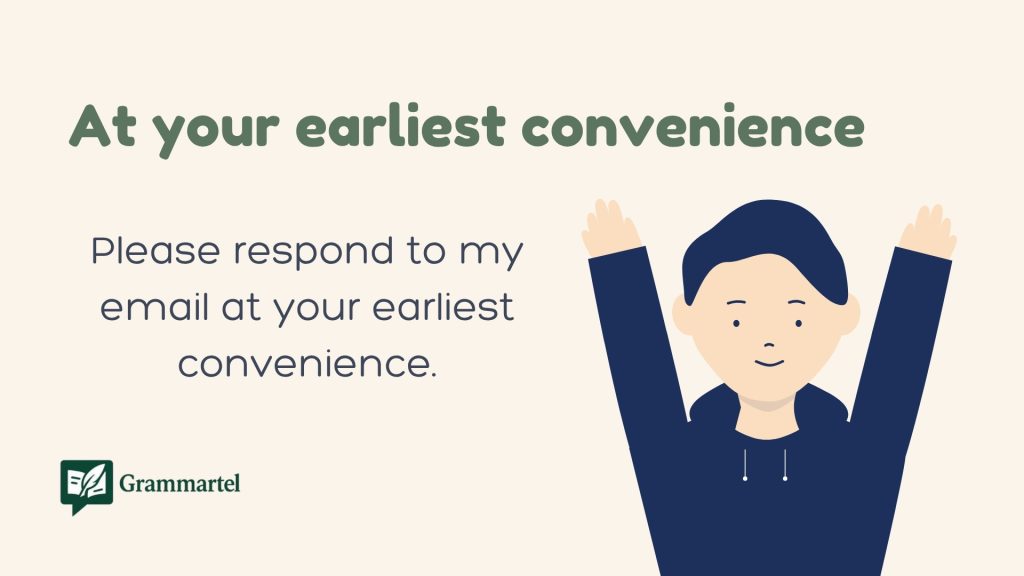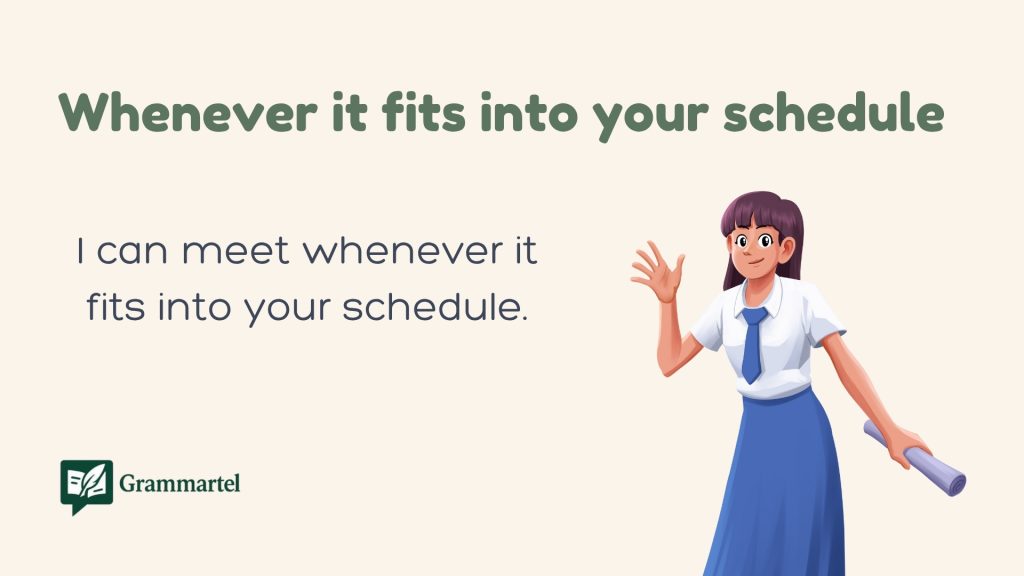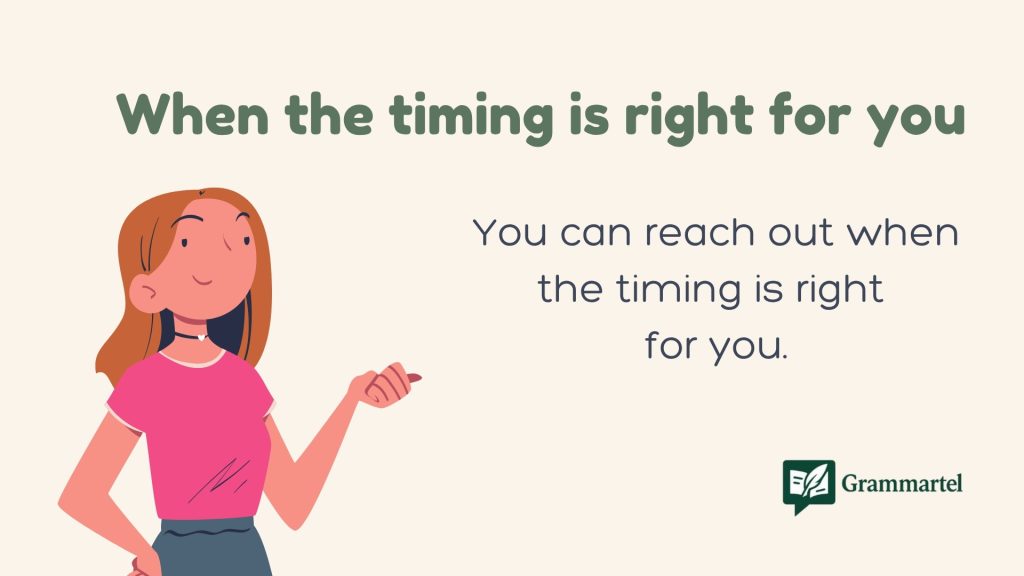When you want to express that someone can do something whenever it works for them, there are several ways to say “at your convenience.” This phrase can come in handy in both formal and casual situations. Whether you’re writing an email, having a conversation, or making a request, knowing various alternatives will make your communication sound more natural and versatile. In this article, we’ll explore 40 different ways to say “at your convenience” with examples to fit every situation.
What Does “At your convenience” Mean?
The phrase “at your convenience” is a polite and professional way of suggesting that someone do something whenever it works best for them. It emphasizes that the action can be completed without urgency and should be done according to the other person’s preferred timing. Essentially, it allows the person receiving the request to decide when it is most suitable or convenient for them to act on the matter, without feeling pressured or rushed.
When to Use “At your convenience”
You can use “at your convenience” in various contexts, typically when you want to make a request but don’t want to impose a strict deadline or time frame on the other person. It’s often used in professional and formal communication to show respect for the other person’s schedule. Here are a few situations when it’s appropriate:
- Scheduling meetings or appointments: You might say, “Please let me know when you’d be available to meet at your convenience,” allowing the other person to choose a time that works best for them.
- Sending requests or follow-ups: If you’re asking someone to complete a task or respond to an email, you could write, “Please respond at your convenience,” indicating there’s no rush.
- Offering assistance: If you’re offering help, you could say, “Feel free to reach out at your convenience,” making it clear they should contact you when it suits them.
- Making non-urgent inquiries: If you need something done but it isn’t time-sensitive, such as, “When you have a moment, please send me the report at your convenience.”
40 Ways to Say “At your convenience”
1. At your earliest convenience

Meaning: When it suits you best, ideally sooner rather than later.
Explanation: A polite way of saying someone can choose when to do something, but with a hint of urgency.
Example: “Please respond to my email at your earliest convenience.”
Best Use: In a professional email when you need a response but understand people have busy schedules.
Worst Use: For informal or casual situations where no urgency is required.
Tone: Polite, respectful.
Be sure to check this out too : 40 Heartfelt Ways to Say “You are Important to Me” (With Examples).
2. Whenever you’re ready
Meaning: Do something when you feel prepared or when it’s most convenient for you.
Explanation: It allows flexibility but with an open invitation to proceed at any time.
Example: “We can begin the meeting whenever you’re ready.”
Best Use: Casual settings or relaxed environments.
Worst Use: When you need something done quickly.
Tone: Relaxed, friendly.
3. At your discretion
Meaning: You have the authority to decide when to do something.
Explanation: Implies that the person has full control over the timing or decision.
Example: “Feel free to call me at your discretion.”
Best Use: In professional settings where you are giving the other person control over the timing.
Worst Use: In situations where the timing is crucial.
Tone: Formal, empowering.
4. Whenever it’s convenient for you
Meaning: Do it when it fits best into your schedule.
Explanation: A polite phrase that emphasizes flexibility on the part of the speaker.
Example: “I can meet with you whenever it’s convenient for you.”
Best Use: Casual meetings or when trying to be accommodating.
Worst Use: When you need a firm commitment or specific time.
Tone: Friendly, accommodating.
5. When you have a moment
Meaning: When you find time or are free.
Explanation: This expression is used to ask for something to be done during someone’s free time, not necessarily immediately.
Example: “Let me know when you have a moment to chat.”
Best Use: Informal or friendly settings, asking for a small favor.
Worst Use: When you need something urgently.
Tone: Casual, considerate.
6. At your earliest opportunity
Meaning: As soon as you are able to.
Explanation: A polite way to ask for something to be done as soon as possible but still flexible.
Example: “Please send me the report at your earliest opportunity.”
Best Use: In professional emails when you need something done promptly.
Worst Use: In informal situations where urgency isn’t important.
Tone: Professional, polite.
7. When it’s most convenient for you
Meaning: When it works best in your schedule.
Explanation: Offers full flexibility on when the action can be taken.
Example: “I’d like to meet with you when it’s most convenient for you.”
Best Use: When you’re trying to accommodate someone else’s schedule.
Worst Use: If you need an immediate response.
Tone: Polite, accommodating.
8. At a time that suits you
Meaning: At the time that works best for you.
Explanation: Giving the person flexibility in choosing when something is done.
Example: “Please let me know a time that suits you for the meeting.”
Best Use: When you are arranging a meeting or appointment.
Worst Use: If you require immediate action.
Tone: Considerate, polite.
9. As soon as you’re available
Meaning: Once you have time to do it.
Explanation: Implies a sense of urgency, but still acknowledges the person’s availability.
Example: “Please call me back as soon as you’re available.”
Best Use: When something isn’t urgent but needs to be done sooner than later.
Worst Use: When there is no urgency and flexibility isn’t needed.
Tone: Respectful, gentle urgency.
10. When you get a chance
Meaning: When you have some free time.
Explanation: A more casual and informal way of asking for something to be done when it’s convenient for the person.
Example: “Please reply to my message when you get a chance.”
Best Use: In informal or casual conversations.
Worst Use: In professional or formal contexts.
Tone: Casual, laid-back.
11. Whenever you’re able
Meaning: When you are capable or available to do it.
Explanation: A polite and flexible way to ask for something to be done.
Example: “Please send me the details whenever you’re able.”
Best Use: Casual or professional contexts when there’s flexibility.
Worst Use: When the task is urgent.
Tone: Polite, neutral.
12. As and when you can
Meaning: When you are able to do so.
Explanation: Suggests that the task can be completed whenever it’s possible for the person.
Example: “Send the documents as and when you can.”
Best Use: In informal settings when flexibility is key.
Worst Use: In urgent or critical situations.
Tone: Casual, polite.
13. At a time of your choosing
Meaning: You choose when it is most convenient for you.
Explanation: Gives the person control over the timing.
Example: “Let me know at a time of your choosing when we can meet.”
Best Use: When offering flexibility and control over scheduling.
Worst Use: When immediate action is required.
Tone: Formal, respectful.
14. At your leisure
Meaning: When it is convenient and relaxing for you.
Explanation: Implies that the task can be done in a relaxed or free time.
Example: “Take your time and get back to me at your leisure.”
Best Use: When offering someone time to think or respond without pressure.
Worst Use: When there’s a need for a quick response.
Tone: Calm, polite.
15. Whenever it fits into your schedule

Meaning: When it works best for you in terms of time.
Explanation: A polite and flexible way to arrange timing.
Example: “I can meet whenever it fits into your schedule.”
Best Use: When trying to accommodate someone else’s time.
Worst Use: In situations where a strict deadline is necessary.
Tone: Friendly, accommodating.
16. At a time that works best for you
Meaning: When it’s most convenient for you.
Explanation: Offers full flexibility in scheduling.
Example: “Let me know a time that works best for you.”
Best Use: When you need to arrange a meeting but want to be flexible.
Worst Use: When something must be done immediately.
Tone: Considerate, respectful.
17. When you’re free
Meaning: When you are not busy.
Explanation: A casual, informal way to ask when someone has time.
Example: “Call me when you’re free.”
Best Use: Informal situations or friendly requests.
Worst Use: In urgent professional situations.
Tone: Informal, laid-back.
18. When it’s most convenient
Meaning: At the best possible time for the person.
Explanation: Emphasizes that the timing is fully up to the person’s availability.
Example: “Let’s chat when it’s most convenient.”
Best Use: Casual or semi-formal requests.
Worst Use: In cases where a more immediate response is needed.
Tone: Polite, neutral.
19. Whenever it suits your schedule
Meaning: When it fits with your plans or availability.
Explanation: A way of being polite and flexible about timing.
Example: “I’m happy to talk whenever it suits your schedule.”
Best Use: When arranging meetings with flexible schedules.
Worst Use: If immediate action is required.
Tone: Professional, courteous.
20. At your convenience, of course
Meaning: You can choose the timing, as long as it suits you.
Explanation: A polite phrase that acknowledges the person’s time availability.
Example: “Please let me know when you’re free, at your convenience, of course.”
Best Use: When offering flexibility in scheduling.
Worst Use: When something is urgent.
Tone: Polite, respectful.
21. Whenever you’re able to manage
Meaning: When you can find the time to do it.
Explanation: A polite request that acknowledges the other person’s schedule.
Example: “Please let me know whenever you’re able to manage the task.”
Best Use: In a professional setting when someone has multiple responsibilities.
Worst Use: In casual or relaxed environments where timing isn’t an issue.
Tone: Professional, polite.
22. As soon as it’s convenient for you
Meaning: As soon as you find the time to do it.
Explanation: A subtle request to prioritize the task when the person is free.
Example: “Please send the report as soon as it’s convenient for you.”
Best Use: When you don’t want to pressure someone but need it done soon.
Worst Use: When immediate action is required.
Tone: Respectful, polite.
23. When you see fit
Meaning: When you believe it is appropriate or convenient.
Explanation: Giving someone the freedom to choose when they want to take action.
Example: “Respond to the email when you see fit.”
Best Use: In casual or non-urgent contexts.
Worst Use: In situations where immediate action is necessary.
Tone: Respectful, flexible.
24. Whenever you feel it’s right
Meaning: When you think it’s the appropriate time to do it.
Explanation: Suggesting that the person can choose the timing based on their judgment.
Example: “Let me know whenever you feel it’s right to discuss this.”
Best Use: When you want to give the person control over timing.
Worst Use: When something is time-sensitive.
Tone: Considerate, empowering.
25. When you’re at ease
Meaning: When you’re comfortable or free.
Explanation: Implies that the task can be done when the person feels they are in a good position to do it.
Example: “Please let me know when you’re at ease to handle the task.”
Best Use: When the person may be busy or stressed, and you don’t want to add pressure.
Worst Use: When immediate attention is needed.
Tone: Calm, compassionate.
26. When the timing is right for you

Meaning: When you believe the time is appropriate for you to act.
Explanation: Suggests that the person can take action when they are ready.
Example: “You can reach out when the timing is right for you.”
Best Use: When providing flexibility without urgency.
Worst Use: In time-sensitive situations.
Tone: Flexible, considerate.
Check out this as well : 40 Ways to Say “As Soon as Possible” with Examples for Conversations.
27. When it works for you
Meaning: When it fits your schedule or is convenient for you.
Explanation: A casual way of saying that the action can happen when the person is ready.
Example: “Let me know when it works for you to meet.”
Best Use: Casual settings where flexibility is appreciated.
Worst Use: When you need something done soon.
Tone: Casual, friendly.
28. When it’s no trouble for you
Meaning: When it doesn’t inconvenience you.
Explanation: A polite way of requesting something that emphasizes not wanting to be a burden.
Example: “Please reply when it’s no trouble for you.”
Best Use: When you’re asking for something but don’t want to impose.
Worst Use: In urgent contexts where an immediate response is needed.
Tone: Polite, humble.
29. Whenever you find the time
Meaning: When you have a moment or are free.
Explanation: A gentle way of saying that there’s no rush to complete the task.
Example: “Please let me know whenever you find the time to talk.”
Best Use: In informal situations when flexibility is key.
Worst Use: When there’s a time-sensitive need.
Tone: Casual, understanding.
30. At your own pace
Meaning: At the speed or time that works best for you.
Explanation: Emphasizes flexibility, allowing the person to take their time.
Example: “Complete the form at your own pace.”
Best Use: In situations where there’s no urgency.
Worst Use: When something requires prompt attention.
Tone: Relaxed, understanding.
31. When you are at liberty
Meaning: When you are free or have the time.
Explanation: A formal way to indicate that the person can act when they are available.
Example: “Please contact me when you are at liberty.”
Best Use: In formal professional communications.
Worst Use: In casual or informal contexts.
Tone: Formal, respectful
32. Whenever you feel like it
Meaning: When you feel inclined or have time.
Explanation: Suggests complete freedom to choose the right moment.
Example: “You can respond whenever you feel like it.”
Best Use: In relaxed or informal settings.
Worst Use: When a timely response is needed.
Tone: Casual, laid-back.
33. As per your availability
Meaning: According to when you are available.
Explanation: A formal way to say that the task can be done when the person has time.
Example: “Please meet with me as per your availability.”
Best Use: In professional contexts where flexibility is appreciated.
Worst Use: In urgent or critical situations.
Tone: Professional, courteous.
34. At a moment that suits you
Meaning: When it works best for you.
Explanation: This allows the person to decide when to do something based on their schedule.
Example: “Let me know at a moment that suits you when we can talk.”
Best Use: When scheduling a meeting or appointment.
Worst Use: If you need immediate action.
Tone: Polite, flexible.
35. As per your schedule
Meaning: Based on the person’s timetable.
Explanation: Indicates that the timing is dependent on the person’s availability.
Example: “Let’s have the meeting as per your schedule.”
Best Use: When trying to arrange a meeting or event.
Worst Use: When an immediate response is needed.
Tone: Professional, accommodating.
36. When you have time to spare
Meaning: When you are free or have a little extra time.
Explanation: A more informal way of asking for something to be done during free moments.
Example: “Please respond when you have time to spare.”
Best Use: In relaxed, informal settings.
Worst Use: When there’s urgency.
Tone: Casual, polite.
37. When it is convenient for you
Meaning: When it’s most suitable or works for you.
Explanation: A direct way of saying the timing depends on the person’s convenience.
Example: “We can reschedule the meeting when it is convenient for you.”
Best Use: When you are offering flexibility.
Worst Use: In situations that need prompt action.
Tone: Respectful, polite.
38. When you’re able to accommodate it
Meaning: When you’re able to make time for it.
Explanation: A formal way to ask for something when the person can fit it into their schedule.
Example: “Please let me know when you’re able to accommodate it.”
Best Use: In professional or formal settings.
Worst Use: In situations where timing is critical.
Tone: Formal, polite.
39. At a time that’s comfortable for you
Meaning: When it is easy or convenient for you to do it.
Explanation: A more gentle, considerate way to suggest timing.
Example: “Please get back to me at a time that’s comfortable for you.”
Best Use: When trying not to pressure the person.
Worst Use: When time sensitivity is involved.
Tone: Compassionate, polite.
40. Whenever you can spare a moment

Meaning: When you have some time to give.
Explanation: A gentle way to ask for something to be done during someone’s free time.
Example: “Let me know whenever you can spare a moment to talk.”
Best Use: In casual, informal settings.
Worst Use: When an immediate response is required.
Tone: Casual, laid-back.
Conclusion
In conclusion, having different ways to express “at your convenience” helps you sound more polished and adaptable. Whether in business or personal settings, using these alternatives can make your communication clearer and more thoughtful. Try mixing them up depending on the context, and you’ll find the right tone every time!
Boost your writing productivity with Grammartel intuitive features.

